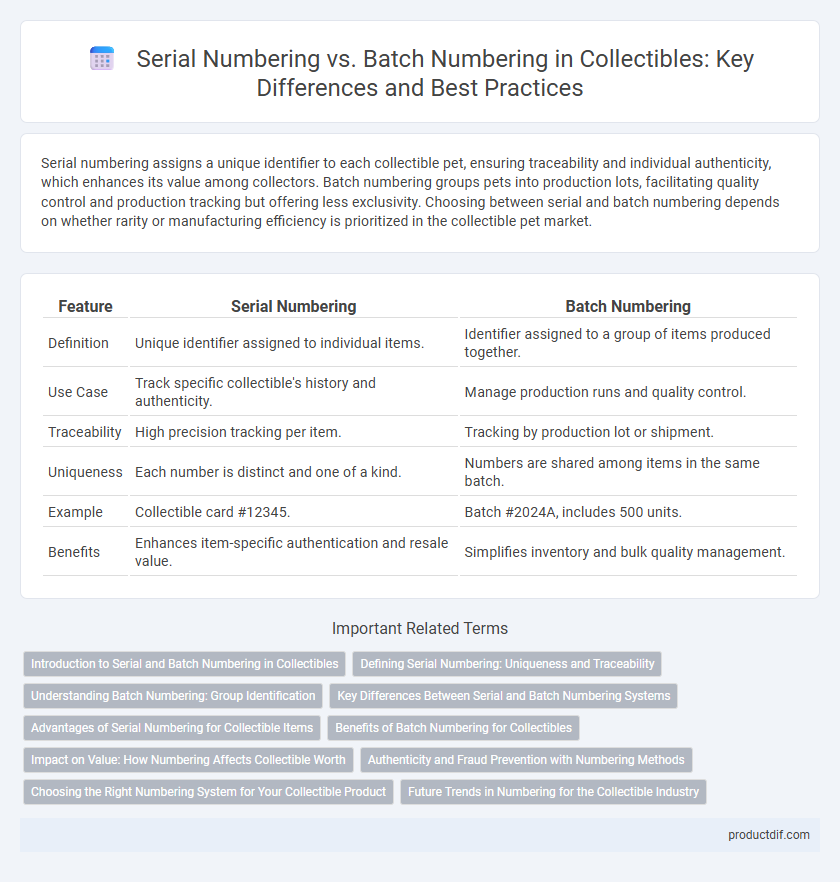Serial numbering assigns a unique identifier to each collectible pet, ensuring traceability and individual authenticity, which enhances its value among collectors. Batch numbering groups pets into production lots, facilitating quality control and production tracking but offering less exclusivity. Choosing between serial and batch numbering depends on whether rarity or manufacturing efficiency is prioritized in the collectible pet market.
Table of Comparison
| Feature | Serial Numbering | Batch Numbering |
|---|---|---|
| Definition | Unique identifier assigned to individual items. | Identifier assigned to a group of items produced together. |
| Use Case | Track specific collectible's history and authenticity. | Manage production runs and quality control. |
| Traceability | High precision tracking per item. | Tracking by production lot or shipment. |
| Uniqueness | Each number is distinct and one of a kind. | Numbers are shared among items in the same batch. |
| Example | Collectible card #12345. | Batch #2024A, includes 500 units. |
| Benefits | Enhances item-specific authentication and resale value. | Simplifies inventory and bulk quality management. |
Introduction to Serial and Batch Numbering in Collectibles
Serial numbering assigns a unique identifier to each collectible item, enhancing traceability and authenticity verification for individual pieces. Batch numbering groups items produced together under a single code, facilitating production tracking and inventory management while maintaining overall batch quality. Both methods improve collectible value by providing detailed provenance and manufacturing insights.
Defining Serial Numbering: Uniqueness and Traceability
Serial numbering assigns a unique identifier to each collectible, ensuring precise traceability and authenticity verification. This system enhances individual item tracking throughout production, ownership changes, and resale, crucial for high-value collectibles. The distinct serial number facilitates detailed provenance records, increasing market confidence and collector value.
Understanding Batch Numbering: Group Identification
Batch numbering enables collectors to identify groups of products manufactured together, providing insights into production timeframes and quality consistency. This system enhances traceability by linking collectibles to specific production runs, crucial for verifying authenticity and condition. Understanding batch numbers helps collectors assess rarity and historical context within a given product line.
Key Differences Between Serial and Batch Numbering Systems
Serial numbering assigns a unique identifier to each individual collectible item, enabling precise tracking, ownership verification, and authentication. Batch numbering groups multiple items under a single identifier based on production runs, simplifying inventory management but limiting item-specific traceability. The key difference lies in granularity: serial numbers provide detailed individual data while batch numbers offer aggregated information for sets of collectibles.
Advantages of Serial Numbering for Collectible Items
Serial numbering offers precise identification for each collectible item, enhancing authenticity verification and provenance tracking. This uniqueness boosts market value and buyer confidence by enabling detailed history and ownership records. Collectors benefit from easier inventory management and loss prevention through individual item traceability.
Benefits of Batch Numbering for Collectibles
Batch numbering enhances collectible management by grouping items produced in the same run, simplifying provenance tracking and authenticity verification. It enables efficient inventory control and quality assurance since each batch shares consistent production characteristics. Collectors benefit from batch numbers by easily identifying limited editions or special releases within a series, adding value and appeal.
Impact on Value: How Numbering Affects Collectible Worth
Serial numbering enhances collectible worth by providing uniqueness and verifiable provenance, which increases rarity and buyer confidence. Batch numbering groups items with shared characteristics, limiting individual distinctiveness but allowing identification of production runs, which can affect value based on batch rarity or historical significance. Collectors often prioritize serial numbers for higher appraisal as they directly signify exclusivity and authenticity.
Authenticity and Fraud Prevention with Numbering Methods
Serial numbering assigns a unique identifier to each collectible item, enhancing authenticity verification by enabling precise tracking and individual item history. Batch numbering groups items under a common code, which aids in identifying production runs but offers less granularity for fraud prevention. Collectors and manufacturers prefer serial numbers for robust counterfeiting deterrence and maintaining provenance integrity.
Choosing the Right Numbering System for Your Collectible Product
Selecting the right numbering system for your collectible product greatly impacts its perceived value and authenticity. Serial numbering assigns a unique identifier to each item, enhancing exclusivity and traceability, while batch numbering groups products by production run, emphasizing consistency and manufacturing details. Carefully consider your collectible's market positioning and customer expectations to determine whether individualized serial numbers or batch numbers best suit your branding and inventory management needs.
Future Trends in Numbering for the Collectible Industry
Future trends in numbering for the collectible industry emphasize enhanced traceability and authenticity through blockchain integration, enabling immutable and transparent serial numbering systems. Advanced batch numbering techniques will incorporate IoT-enabled sensors, providing real-time data on provenance and condition throughout the supply chain. Digital twins paired with AI analytics will revolutionize collectible verification by linking unique serial or batch numbers to dynamic, evolving ownership histories.
Serial Numbering vs Batch Numbering Infographic

 productdif.com
productdif.com